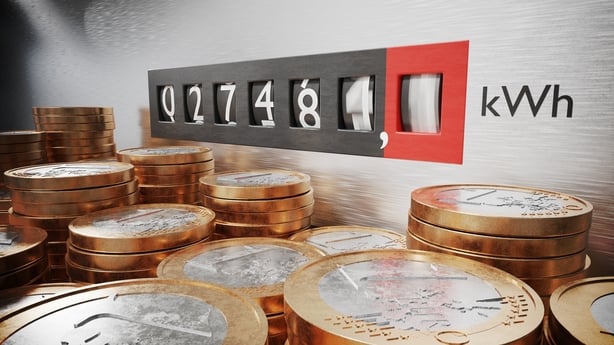The economic fundamentals of security, food, shelter and energy all came into sharp relief this year when Russia invaded Ukraine at the end of February.
That one terrible event precipitated a shock that disrupted markets in food, energy and a wide range of commodities and raw materials.
Its human toll was far greater, of course, with cities across Ukraine destroyed and tens of thousands of people killed.
It has also forced over two million Ukrainians to seek shelter across the EU, including over 60,000 who have arrived in Ireland.
Meanwhile, the economy here continued its remarkable recovery from Covid, led in large part by the multinational sector. Tax revenues rolled in; the corporation tax boom got even boomier.
And while the domestic economy showed clear signs of slowing towards the end of this year, employment levels reached record highs.
ENERGY
At the outset of the war in Ukraine, the EU imported 43% of its gas needs from Russia. Some countries, like Germany, had a higher dependence with Russia accounting for two thirds of its gas imports and a key input for much of its energy-intensive manufacturing industry.
By August, the percentage of Russian gas consumed in Europe had dropped to just over 17%. By next year, it's likely to be lower again.
Captured between those two figures are tumultuous months when decades of energy policies and diplomacy were torn up and the Nordstream gas pipeline from Russia under the Baltic Sea was literally blown up.
Consumers saw prices rise to almost six times higher than their normal pre-war levels before falling back to some extent at the end of the summer as gas storage tanks filled up.
We learned (but perhaps did not fully understand why) that in the complicated structure of Europe's deregulated energy markets, the price of gas set the price for traded electricity.
So, the price of electricity duly shot up too, particularly in national grids with high dependence on gas generation like Ireland's.

At the end of this year, consumers are paying electricity bills that are almost two thirds higher than a year ago and gas bills which have almost doubled.
Europe got through the bulk of demand for this winter through a massive increase in the importation of liquified natural gas (LNG) brought in on tankers from places like the US and Qatar.
The issue of energy security will be back next year. In Ireland, proposals are awaited on energy security which will follow a public consultation which itself was based on a consultants’ report published in September.
The critical issue remains gas storage. There are no gas storage facilities in Ireland and no regasification plants to turn tanker-borne LNG back into mains gas.
Three quarters of our gas supplies come through a pipeline from Scotland. The Corrib field is predicted to be depleted by the end of this decade so that dependence will only grow.
INFLATION
Inflation had already begun to stir from a decade-long slumber towards the end of 2021. But those seemingly transitory post-Covid supply chain blues seem almost benign in comparison to the inflation which clobbered the euro area and Ireland this year.
Energy was, of course, the cause of the explosion in inflation which in many ways characterised 2022 in economic terms and marks this year as a turning point.
Monetary policy at the European Central Bank and other central banks has turned to what central bankers call "normalisation".

In plain terms, this means raising interest rates closer to their long-term historical trends and reversing the money-printing practice of "quantitative easing".
Inflation peaked this year in the euro area at 10.6% in October. The highest rate recorded in Ireland measured by the Consumer Price Index was also in October when it peaked at 9.2%.
Food inflation has also emerged to significantly dent household incomes as shock inflation in fertilisers and other inputs at the outset of the war in Ukraine work their way through the food chain.
There is hope that we’ve come through the worst of this cycle of inflation. That’s generally understood to mean a slowing in the rate of inflation rather than prices coming down.
However, considerable uncertainty remains over what might happen to energy prices if Europe goes through an exceptionally cold winter and sourcing new gas supplies next year becomes problematic once more.
CORPORATE TAXATION
This year the mind-boggling mystery of Ireland's corporation tax mutated into a Sphinx beyond comprehension.
November's tax take was the biggest monthly return on record. A big chunk of that was down to an unprecedented €5 billion in corporation tax last month which means the public finances are on course to collect €23 billion in corporate tax this year, making it the second biggest source of tax after income taxes.
It was initially forecast by the Department of Finance that around €14 billion in corporate tax would be collected in 2022. That figure has been gradually revised upwards over the year.
And according to a report from the department earlier this year, over half came from just ten multinationals.
This all means corporation tax is likely to have almost doubled in just two years since 2020 when €11.8 billion was collected.
Theories abound over what's behind this windfall of potentially destabilising good fortune.

Most experts point to a change in US tax rules in 2015 which meant intellectual property owned by technology companies and pharmaceutical companies (such as software codes, patents and medicine formulas) could no longer be held by shelf companies registered in tax havens.
This led to massive "imports" of intellectual property to Ireland where many of these companies have operations that employ thousands of people, another new rule.
For a few years, the cost of the intellectual property could be offset against tax by these companies. Now, those tax allowances are expiring so the tax on the profits attributable to them is going up.
Throw in a pandemic when pharmaceutical, technology and digital companies all did very well and the potential for taxable profits takes an exponential shift upwards.
The big question is if this is a once-in-a-pandemic profit bonanza which will tear like a meteorite through our public finances leaving frayed nerves and tattered spending promises or if we’ve arrived at a status quo of corporate shape shifting that will continue to feed the Exchequer and leave our European neighbours enviously pointing accusing fingers in our direction.






